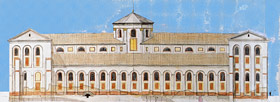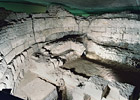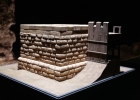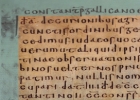Roman Cologne
Cologne's history can be traced back to a time around the birth of Christ, when the Roman Emperor Augustus and his imperial governor Agrippa decided to found a new city where the Rhine emerges from the narrow river valley into the plain. It was to be the capital city of the planned province of Germania that stretched from across contemporary Switzerland to the Netherlands and to the River Elbe in the east. Immediately after the decision was made, the construction of a stone fortification, of which the Ubian Monument has survived to this day, was inaugurated. Also the imperial governor's residence, the Praetorium, was built. As Rome had settled the allied Germanic tribe of the Ubii in the Rhineland, the new administrative centre was given the name "oppidum Ubiorum"(City of the Ubii). This is also where the province sanctuary was built, the Ara Ubiorum (probably in the area where the Gurzenich building stands today).
After the defeat of Varus in 9 AD, the remaining Roman troops withdrew to the Rhine border. Cologne was turned into the capital city of the military district of Lower Germania and then moved on to become the capital of the entire province of Lower Germania. Around 50 AD, Emperor Claudius, at the request of his Cologne-born wife Agrippina, elevated the town to a colony with Roman town privileges. From then on, Cologne carried the name COLONIA CLAUDIA ARA AGRIPPINENSIUM.
Many emperors visited Cologne, either for long or for short stays. It was here that, in 98 AD, Trajan, who would lead the Roman Empire to the height of its power, received the message of his election as emperor. The messenger was none other than his relative and successor Hadrian, who at that time was stationed as a military tribune in Upper Germania. In 355 AD, the usurper Silvanus was proclaimed emperor in Cologne and was also murdered here.
Cologne was an imperial seat (260-274) under the rule of Marcus Cassianus Latinius Postumus and his successors, the former being the first emperor of the Gallic Empire (Imperium Galliarum) that emerged 260 AD when the western provinces of the Roman Empire broke away from Rome.
Monumental architecture such as the first Rhine Bridge and the bridgehead, the castell of Divitia (modern-day Deutz), was built at the behest of Emperor Constantine (306-37).
Throughout all the eras of the Roman presence, the governor's palace, the Praetorium, grew in both size and splendour.
The end of Roman rule in Cologne corresponds roughly with the death of the west-Roman supreme commander Flavius Aetius in 454.
Already during Roman times, Jews resided in Cologne
Jews have probably lived in the province of Lower Germania since the end of the first century AD. By the fourth century they constituted a large and significant community.
In 321 AD, Emperor Constantine the Great sent a letter to Cologne in which he assented to having Jews appointed to the Town Senate, the Curia. Only a large and well-off community was capable of providing members for such a municipal honorary position because in late Antiquity members of the curia faced massive private financial burdens. This form of participation was therefore a heavy and more or less involuntary duty.










